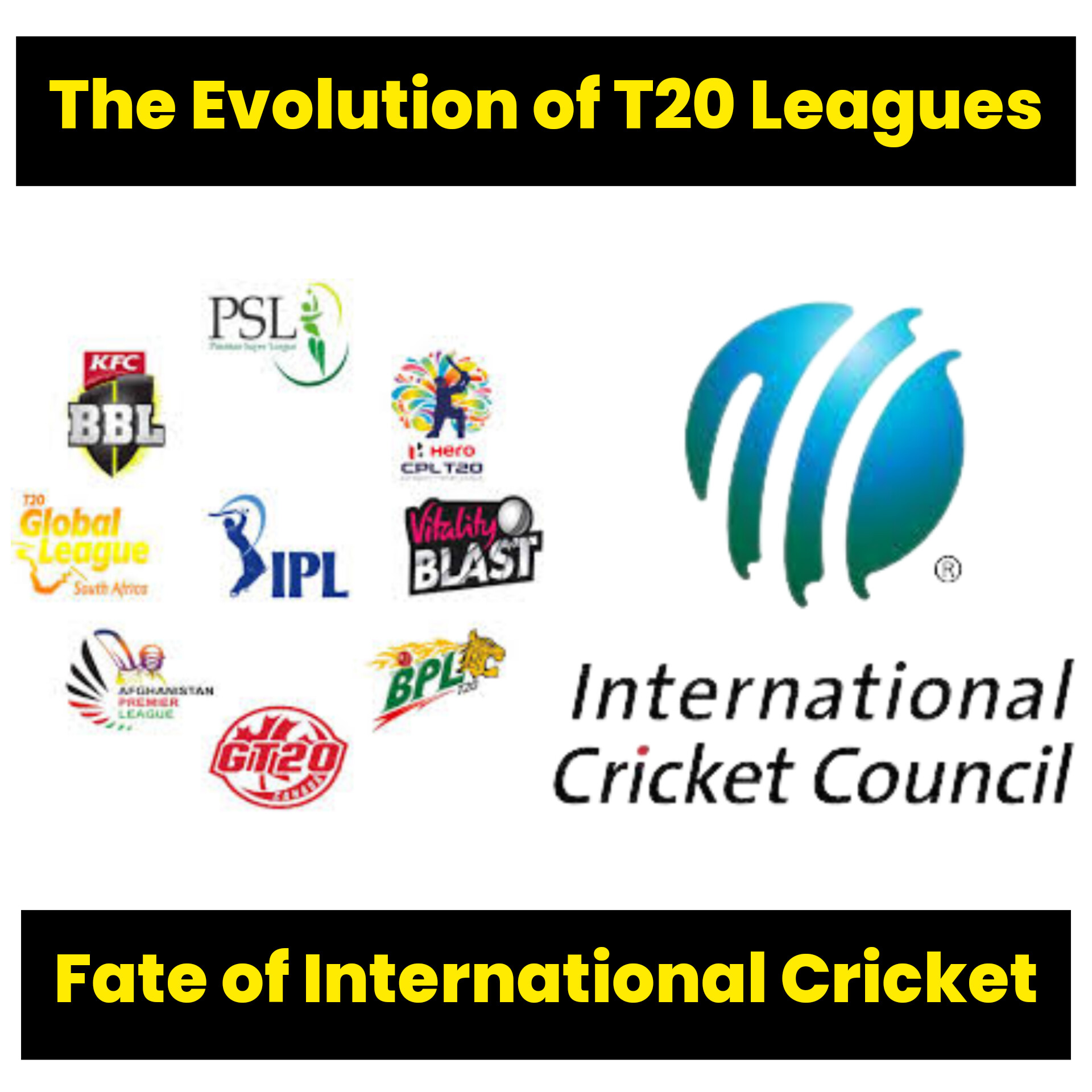Introduction
Cricket, once primarily known as a sport played between nations, has undergone a transformation in recent years with the sudden rise of T20 leagues around the world. The advent of leagues like the Indian Premier League (IPL), Pakistan Super League (PSL), Big Bash League (BBL), and others has introduced a new dimension to the sport. While these leagues have provided opportunities for emerging talents, boosted player incomes, and enhanced overall entertainment, they have also sparked concerns about the future of international cricket.
The T20 League Phenomenon
The growth of T20 leagues has been a bonus for cricket enthusiasts globally. With fast-paced action, big hits, and nail-biting finishes, these leagues have captured the attention of fans, going above geographical boundaries. Each league, owned by its host country, brings its unique flavor, drawing players and viewers alike into a captivating cricketing festival.
The IPL, initiated by the Board of Control for Cricket in India (BCCI), set the precedent for T20 leagues. Its success in combining cricket, entertainment, and business paved the way for other nations to launch their own leagues. The PSL, BBL, CPL, and LPL followed the script, further fueling the T20 passion. These leagues have become platforms for not only established cricketers but also upcoming talents to showcase their skills on a global stage.

The Positive Side
1) Financial Windfall:
One of the most apparent benefits of T20 leagues is the considerable financial rewards they offer to players. With lucrative contracts and backing, cricketers can significantly enhance their earnings compared to what they might earn from domestic and international cricket alone. This financial stability provides players with economic security and opens up new paths for future investments.
2) Global Exposure:
T20 leagues provide a platform for players from various countries to showcase their skills to a worldwide audience. This exposure not only enhances a player’s repute but also broadens their fan base and opportunities for playing in different leagues around the world.
3) Learning from Legends:
Young and emerging cricketers get a chance to share dressing rooms with international stars. This exposure allows them to learn from experienced players, absorb their knowledge, and gain insights into different aspects of the game. Such mentorship can be very useful for the development of young talents.
4) Skill Enhancement:
The fast-paced nature of T20 cricket demands that players constantly refine their skills. The pressure-cooker situations of T20 leagues force players to adapt quickly, fine-tune their techniques, and develop innovative strategies to succeed. This skill enhancement often translates into improved performance in other formats as well.
5) Mental Toughness:
T20 leagues subject players to high-pressure situations, which can contribute to the development of mental toughness. Handling tense moments, making split-second decisions, and staying composed under pressure are skills that players cultivate in T20 leagues, skills that are transferable to international cricket.
6) Innovation and Entertainment:
T20 cricket encourages innovation and experimentation. Players are more inclined to attempt innovative shots, bowling variations, and fielding strategies. This element of experimentation adds excitement to the game and keeps fans engaged.

You May Also Like: India-Pakistan Clash on 14th October at Ahmadabad, Anticipating a High-Stakes Encounter
The Negative Side:
1) The Struggle of International Cricket
The rise of T20 leagues, while contributing to the growth of cricket as a whole, has also cast a shadow over the future of international cricket. With players preferring league contracts over national duties, the question arises: “Is international cricket slowly losing its charm?”
The attraction of lucrative contracts, exposure to world-class players and improved living standards has led many players to lean towards T20 leagues, occasionally leaving international fixtures with weakened squads.
While T20 leagues have brought about significant benefits to the cricketing landscape, they are not without their drawbacks. Here are some of the disadvantages associated with T20 leagues:
2) Risk to International Cricket:
One of the most pressing concerns is that T20 leagues can potentially overshadow international cricket. Players’ preference for league commitments over international matches can weaken national teams, impacting the quality of International cricket.
3) Inconsistent Performance:
Frequent shifts between different leagues with changed conditions can lead to inconsistent performances. Players might do well in one league but struggle to adapt to another due to differing playing conditions and opposition.
4) Impact on Domestic Structures:
The focus on T20 leagues can switch attention and resources away from domestic cricket structures that bring up talent for International formats. Traditional formats like Tests and One Day Internationals (ODIs) might receive lesser importance in terms of player development and infrastructure.
5) Reduced Importance of Technique:
While T20 leagues encourage innovation and aggression, they might inadvertently place less emphasis on traditional batting and bowling techniques. Players might prioritize power-hitting over building solid innings or developing nuanced bowling skills.
6) Pressure on Young Talents:
While T20 leagues provide opportunities for emerging players, the extreme competition and pressure to perform can be upsetting for youngsters. The pressure to impress in a shorter format might not necessarily nurture their all-around cricketing skills.
7) Viewership Issues:
In conclusion, while T20 leagues offer a host of benefits, they also come with a set of challenges that need to be carefully managed. Striking a balance between the growth of leagues and the preservation of international cricket’s essence is essential to ensure the sustainability and health of the sport in its entirety.
The viewership for international matches, especially bilateral series, has faced challenges due to the ever-expanding league calendar. The changing scene has led to a dilution of the significance attached to representing one’s country. As a result, cricket boards are struggling with ways to create a balance between the demands of domestic leagues and preserving the spirit of International cricket.
Conclusion
The rise of T20 leagues has certainly reshaped the cricketing landscape, injecting excitement, entertainment, and opportunities into the sport. However, the growing fame of these leagues should not compete with the significance of international cricket. Creating a good balance between the two formats is crucial for maintaining the purity of representing one’s country while enjoying the benefits of league cricket.
Cricket boards, players, and cricketing bodies must work collectively to create a framework that cares for both international cricket and T20 leagues. This delicate balance will ensure that the game continues to evolve, fascinate audiences worldwide, and provide young cricketers with a pathway to fulfill their dreams while honoring the legacy of the sport.



















Essence Cash Tall Girl Basketball Player Only Fans Leaks – https://Leaks.Zone/Emonneeyy_Mega
Exactly Feet Mega Link Folder Only Fans Leaked – https://t.me/UCSTG
cialis drug
synthroid online no prescription
where to buy lisinopril online
discount canadian pharmacy cialis
cost of synthroid brand name
lisinopril 2.5 mg coupon
cialis soft 40 mg
[url=http://doxycyclineo.com/]doxycycline capsules for sale[/url]
tor marketplace https://mydarkmarket.com/ – darknet markets 2024 darkmarket url
batmanapollo.ru
Everything has a second side (У всего есть вторая сторона)
Ad usum externum — Для внешнего употребления.
dark internet [url=https://mydarkmarket.com/ ]deep web drug url [/url] darkmarket 2024
Acta est fabula! — Пьеса сыграна!
Ad oculos — Наглядно
Ad majorem Dei gloriam — К вящей славе Божией